Rug Repair Tour
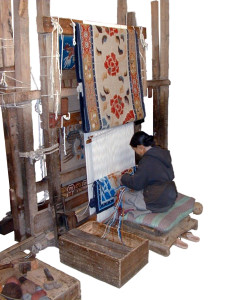
Tibetan Weaver at Her Loom
Woven rugs are crafted knot by knot by a weaver.
The wool is sheared, dyed, spun, and then woven into rug.
A rug can take months or years to weave depending on the size and knot count of the piece. For example, a 9×12 rug woven today in Pakistan, good quality weave, would take 3 weavers sitting side by side 6 days a week FOURTEEN months to weave that one rug.
Rugs are literally a piece of a weaver’s tradition, heart, and soul on your floor. They are magical, and can last centuries when well-cared for. We don’t look at rugs as being a part of our lives, but us being a part of THEIRS.
So we pay close attention to problems that come up with the structure of a rug, so that we can protect the work of these craftsmen and women, and the rugs they have created for the world to enjoy.
Every rug is pre-inspected when it arrives to us, and we pay special attention to the sides, ends, and field for any areas of concern.
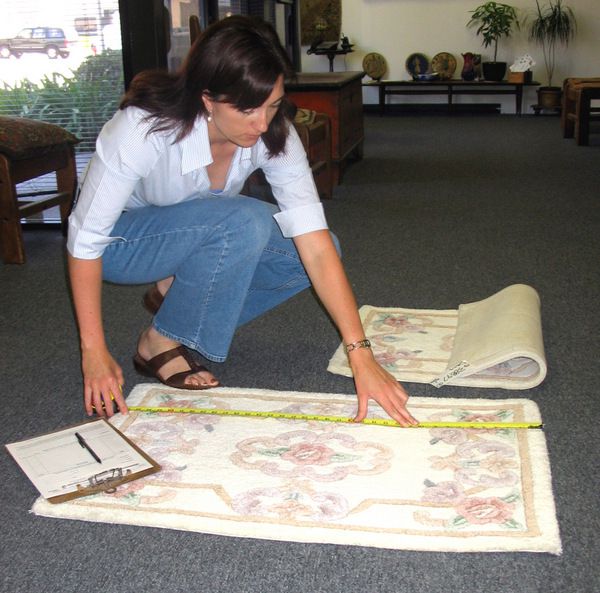
PRE-INSPECTION
Rugs that come to us for repair are thoroughly inspected to identify the damage, the cause of that damage, and the various options available to correct or minimize that damage. Our goal is not only to make the rug “look” better cosmetically, but to also make certain that the structure of the repaired area is strong enough to allow you to use and enjoy your rug without worrying about further damage.
Rugs are woven to last decades at the least, and centuries at the most, and rugs of all ages travel through our doors. Our specialty is antique and semi-antique rug care, and our knowledge regarding these textiles allows us to give you the information necessary in making the right rug care decisions. If a rug gets to the point that it is “past its prime,” we will let you know what type of floor, type of pad, and level of traffic would be best to help the piece last longer.
FRINGE & END REPAIR:
The Fringe is the “Skeleton” of Your Rug
Most rugs have white cotton fringe tassels, and others have wool or silk tassels (depending on where and when they were woven). Some rug owners like the look of the fringe on their rugs, to others it drives them nuts to always be straightening them, or keeping them from getting caught in the vacuum cleaner (that’s why you vacuum from side to side instead of from end to end).
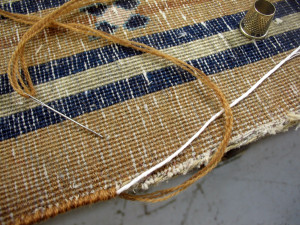
Securing an unraveling edge
But, the fringe is not just a “pretty” way to finish the rug – it is actually the foundation fibers of the rug. The rug’s “skeleton.” Each individual tassel that you grab in your hand runs through the middle of the rug all the way to the other end, emerging as another individual tassel on the opposite end.
White cotton warps are strung around the loom wood plank, and when the rug is cut off, those strands become its fringe tassels.
WARP:
Each individual foundation strand that runs the length of a rug. These strands end up being the fringe tassels of the rug.
WEFT:
Each individual foundation strand that runs the width of a rug to hold the rows of wool knots in place. We remember these as being the strands that run “weft” to “wight.”
Because the tassels are the warps of a hand woven rug, torn or worn fringe is damage to pay special attention to. This damage can easily result in your rug unraveling and losing its knots (this is where the labor – and value – of a rug is).
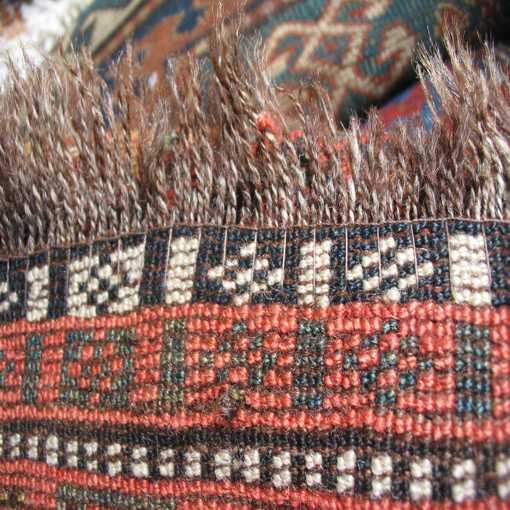
Back view of a secured end of a tribal weaving.
OVERCAST (SECURING) STITCH
A proper overcast stitch (by hand) along the end of a rug will anchor the knots in place so that they will not “slide” off of the warps of worn rugs. This is a simple looking stitch (either a buttonhole or cross-stitch variety), but knowledge about how to properly anchor the stitch to a weft thread is key. A poorly executed stitch will lead to a tension inconsistency that can result in additional knots unraveling from the rug.
A minimum of an inch of original fringe (exposed warps) tassel is needed for a correct overcast stitch, and it is ideal to have one consistent row of knots to anchor together from left to right – this many times means that the rug must be evened out beforehand to prepare it for the overcast stitch. With the proper conditions met, this leads to a superior overcast stitch.
This repair service, when done properly, should then last and never have to be redone (barring some extreme damage such as from a vacuum or a dog’s teeth). It is the one service that we guarantee for the life of your rug.
FRINGE REPLACEMENT
The fringe is the first thing to go on a rug. It’s inevitable. Years of footsteps on individual tassels cause abrasion. Vacuum cleaners cause damage. And they both contribute to tearing, fraying, and an eventual wearing down of the tassels.
Most of the time we want our rugs “fixed” with new fringe because it just looks bad when the original fringe is worn. It’s a noticeable thing to fix, and it is the most common repair that comes through our doors.
First the end must be properly secured with an overcast stitch so that the structure of the rug is sound. Then a new prefabricated fringe can be laid along the top of the original fringe base, and attached by hand. Because the fringe is laid on top of the original fringe base (the original tassels are trimmed shorter so that they do not “peek” through the new tassels) it protects the end of the rug from further foot traffic abrasion. Now the “new” fringe takes all of the abuse from footsteps.
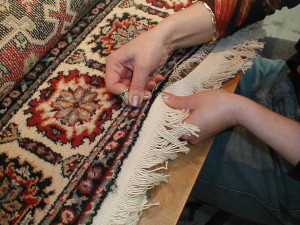
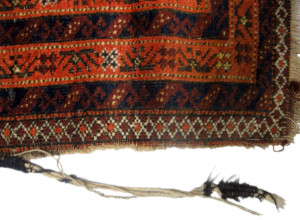
Side cords pull off… and the rug falls apart
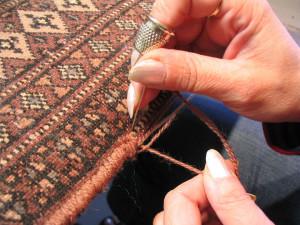
Side secured, new cord added, and wrapped in wool
SIDE REPAIR
Just as tied-off fringe tassels hold the knots in place from the ends; the side cords hold the knots in place from the sides. The weft (left to right) threads are wrapped around a thick side cord that runs the entire length of the rug (with the warps). This cord holds the rows in place, and is usually (after the weaving is completed) wrapped in wool, cotton, goat hair, or silk. The over-wrapping is usually done in a color that blends well with the overall look of the rug.
Sometimes multiple rugs are woven on the same large loom for higher production numbers. When this is done, the rug wefts are shared between the rugs. To separate the rugs then, the shared wefts need to be cut. This means that these wefts are not wrapped securely around a side cord. In fact, what is often done is a side cord is already over-wrapped in a matching color and they baste it to each side of the finished rug without securing the original “loose” weft threads. This makes the rug “look” right, but there’s a problem with this…
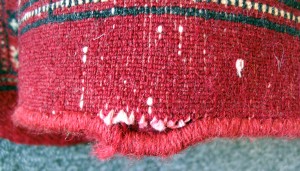
Back side view of a Pakistan Bokhara
PAKISTANI PERFORATIONS
Contemporary rugs from Pakistan are a good example of this type of finishing on the sides that creates problems with their weaving shortcut. Because the wefts are not secured properly to the side cords, you can pull hard on the side and literally pull it off.
This can happen with a shoe heel, or a vacuum cleaner, or a pet’s bite. And it pulls off almost as if the side is perforated. Some Pakistani rugs are woven in pairs, so there may be only one “shared” side that has this problem. Repairing the problem can be costly if you do not catch it quick enough.
This weaving characteristic is not just a Pakistani rug characteristic – you find it also in several India and Persian pieces as well. The fear is that you’ll pull the side loose and will begin losing knots. However, this can be fixed by either adding additional securing stitches to the existing side cord (to delay replacement), or by removing the original cord and replacing it with a new one that is properly anchored to the body of the rug. Flip over the sides of you rug onto itself and inspect them to see if there are any loose areas along the sides. If you catch the problem early, it is a very inexpensive repair.
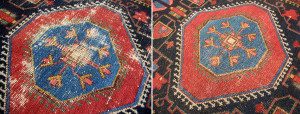
A Hamadan receives some flatstitching and dyeing. It is a cosmetic repair (not restoration).
FIELD REPAIR: Securing & Dyeing
Small holes and tears in the center of a rug can be caused by many things – excessive foot traffic, furniture friction (rolling chairs), planter water damage (dry rot), or just old age. Regardless of the cause, the area needs immediate attention to ensure further loss of knots is avoided.
Embroidery stitching can strengthen small worn areas to protect fragile foundation fibers from further friction. If the hole is significant, then patching or reweaving will be needed. Selective dyeing is a “cosmetic” repair to make your rug look better. Permanent textile dyes can be used to blend away worn areas, discolored areas, white knots, and repairs. On collectible rugs dyeing beyond some small particular areas can adversely affect the value of the rug. We will share the positives and negatives in these situations with you as we inspect your rug so that you can make an informed, educated decision.
HANGING TEXTILES
Many rugs make striking wall hangings, and showcasing them as your piece of art is a popular choice for many textiles from silk rugs to tapestries to American Indian weavings. Some fragile pieces that cannot be walked on any longer can also be prepared to hang so that you can continue to enjoy their magic in your home.
Velcro
The Textile Museum recommends using velcro to hang textiles, so we offer this to our clients to hang their textiles for display. The velcro is attached by hand to the rug, and then the mate piece is attached to a piece of wood that you can then secure to your wall. The advantages of using velcro are:
- The rug can be adjusted to hang evenly (rugs are rarely symmetrical, so this allows you to make slight adjustments).
- The rug lays against the wall more evenly.
- It makes it easy to take down to vacuum with an upholstery attachment or canister vacuum (at least quarterly to ensure no insects are making a home behind them).
Sleeves
If you would like to use a decorative rod to hang your rug with, then a sleeve can be sewn along the back of the rug by hand to slide the rod through. This does not hang as evenly against the wall as Velcro does, but we can do this regardless.
Frames
Another option is to attach a rug to a material covered frame to “mount” the rug on a wall. We do not recommend encasing a rug in a Plexiglas or plastic, or anything that is airtight – offgassing of the fibers (especially moisture evaporation from wool fibers in extreme heat) can lead to mildew and other deteriorating conditions.
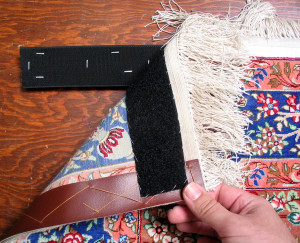
Velcro used to dispaly a silk rug
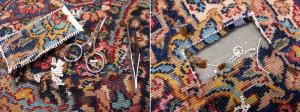
A Karastan Gets a Patch
Thoughts on Restoration:
Is It Worth It?
Restorative work is possible for certain textiles depending on the damage in need of correction, and also depending on prior chemical or repair work already performed on the rug. We offer restorative services that are both wash and repair related.
Reweaving New Fringe Tassels (wool, cotton or silk)
If there is limited fringe damage (some torn tassels, but the entire end is not worn), then new tassels can be strung into the rug to replace the missing warp strands. Also, if you do not like the “look” of the replacement (prefabricated) fringe, this is an option for you.
Reweaving Holes or Torn Areas
Our weaving team has the ability to reweave many textiles, from holes in the field, to side and end reweaving, to replacing wool knots in worn areas. The cost and turnaround time varies with the type of materials and knot count. We have an accomplished tapestry, Turkish Kelim, and American Indian restorer on our team (Lesley). Kate also is a master at working on especially Persian and Turkish pile rugs. We have handled restoration work of all ages and countries of origin.
Many times a patch is more preferable and cost-effective than reweaving a sizeable hole. The key is to secure the rug AND the patch individually so that they fit together tightly and will not come apart when placed back on the floor. The most important aspect of the patch is not the color, but the foundation structure. A tightly woven remnant used as a patch in a loosely woven rug will lead to it tearing away in the future. We locate a remnant that has a similar foundation structure first, and then we can alter the appearance with stitching and dyeing to help it “blend” in with the look of the rug it is being placed in. [This is technically considered “repair” rather than true “restoration” since the rug is not returned to its original condition, but rather made usable again and removing the source of further damage.]
WASH RELATED RESTORATION:
Color Run Removal
It is sometimes possible to reverse bled dye damage, where a rug that has been bled due to water exposure from a flood or an improper cleaning in the home. Sometimes the damage can be lessened or removed. Not every rug is a candidate for this work, and some pieces improve better than others do. It depends on the country it’s from, the fibers used, the source of the color run (water, pet urine, coffee, bad cleaning, etc.), and whether there have been any corrective measures taken already.
Pet Urine Stain Stripping
Pet urine stains, because they are stains that go on hot and acidic, essentially re-dye the fibers and set it in the same step. This can lead to a color loss in some chemically treated rugs (such as with most new rugs, especially Chinese) that is irreversible … but in other rugs the urine stains the fibers yellow without loss of the original rug dye, and this makes stripping of the urea in the urine a possibility to make it look better. Pet urine is one of the most damaging “spills” on a rug that leads to devaluating damage. For tips on how to quickly treat pet puddles to help prevent rug disasters, visit our Rug Spill Tips.
With pet stains, the longer they sit on the rug, the worse the damage. It goes from an acidic stain to an alkaline one, which works against the natural dye/fiber bond of the rug’s acid dyes. This means when the rug is eventually washed, the dyes in all of those areas will lose color even if a proper dye stabilizing solution is used. This is because the pet urine “dissolves” the dye away, and it is no longer holding onto the fibers, so it just washes away. This is why pet puddles devalue rugs. You can sometimes make the damage less noticeable, but the damage IS still there.
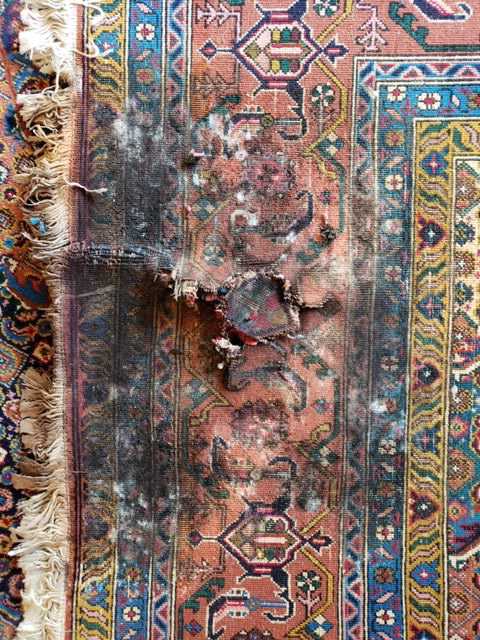
Sanitizing Soak (Mold, Mildew, and Bacteria)
All rugs that are exposed to water unintentionally need to be sanitized to alleviate any mold or mildew growth that could lead to dry rot in the rug’s foundation. Whether by a flood, or a nearby planter that has leaked, the rug needs to be immersed in a sanitizing solution to remove anything that might cause problems in the future. Any rugs involved in floods need to be properly washed before returned back into the home. For tips on how to handle rugs from floods, visit our Rug Care Tips.
Moisture from a house plant led to mildew damage and dry rot in this rug
Peroxide Treatment (Whitening of Yellowing Rugs)
Over time wool exhibits a yellowing that is especially noticeable in off-white or ivory rugs. This can sometimes be lessened through a “whitening” process that uses a low concentration of hydrogen peroxide. The process is applied in phases to avoid damaging the fiber structure (high concentration hydrogen peroxide is sometimes used by inexperienced cleaners to quickly “whiten” cotton fringes … which can cause them to fall apart). Not every rug will respond to this treatment, but we will let you know if your rug is a candidate. This is akin to whitening your teeth.
Red Dye Stain Stripping (Food Coloring and Red Wine Stains)
Red dye (and other food dyes) can sometimes be stripped from the fibers, though the longer the stain sits the more difficult the removal process is. Also, some chemically treated rugs (Chinese especially) cannot have this food dye stripped without the rug dye being stripped as well. Attempts will only be made on rugs that can be corrected safely.
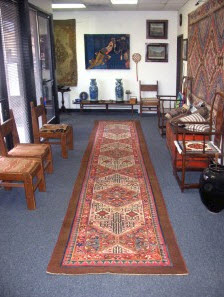
Come See The Magic Yourself
There are always some interesting repair projects in motion in our Rug Plant. We also host the monthly San Diego Weavers Guild meetings in our facility, where they share Old World dyeing and weaving crafts with one another in the midst of all of our hand woven textiles.
Old World magic in a New World… at our little rug shop!
If you have rugs you care about, give us a call and come visit our company. We guarantee that there will never be a place you’ve been to quite like our little corner of San Diego. Call and set up an appointment 858-566-3833 to come tour our repair and wash facility, and we can give you all of your options in caring for your rugs.
We look forward to meeting you… and your rugs! 🙂

